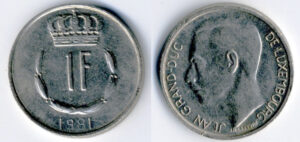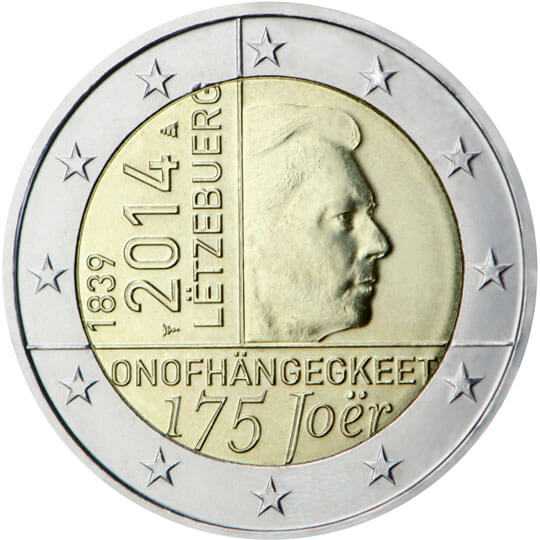Coining National Identities: Luxembourg
His Royal Highness Henri, Grand Duke of Luxembourg, Duke of Nassau, Prince of Bourbon-Parma, Count of Sayn, Königstein, Katzenelnbogen and Diez, Burgrave of Hammerstein, Lord of Mahlberg, Wiesbaden, Idstein, Merenberg, Limburg and Eppstein, is depicted on the national side of all euro coins issued by the Grand Duchy of Luxembourg. He took office on 7 October 2000 following the abdication of his father Jean.

Luxembourg’s 1 franc coins, like this one from 1981, were not issued in great quantities every year, as small countries don’t have nearly as much demand for coins as larger ones. In the early 1990s, the nation issued enough 1 franc coins to cover its demand for many years – until the euro arrived. Photo: Maksim / CC BY-SA 3.0
Small Countries Don’t Mint New Coins Every Year
We’ve become accustomed to seeing new circulation coins issued every year, each one bearing the year it was minted. Historically speaking, this is a relatively new phenomenon. For centuries, coins were only minted when there was great demand for them in that nation. If the materials and production processes were too expensive in proportion to the seigniorage, nations preferred to go without new coins and simply accepted that there would be coin shortages within the population. Take the famous example of the coin shortage in late 18th-century England: to make up for the shortage, manufacturers started striking private tokens, which are some of the most colourful and fascinating tokens that the world of numismatics has to offer.
Until the introduction of the euro, Luxembourg did not reissue each denomination every year either. For example, the 1 franc piece was only minted in 1988, 1989, 1990 and 1991, each time in large quantities. With 3 million pieces minted in 1989, 25 million in 1990 and 10 million in 1991, the nation’s demand was covered for over a decade. Between 1992 and 1995, this coin was only available in sets for collectors. From 1996, the production of circulation coins was completely discontinued.
New Ruler, New Currency
As a result, the nation’s previous ruler Jean of Nassau is depicted on the old franc, while his son Henri is depicted on the new euro as head of state.
Jean was born in 1921, son of the ruling Grand Duchess Charlotte. The Second World War displaced the entire family. Aged 21, Jean joined the British regiment of the Irish Guard, which was actively involved in the liberation of Normandy and Brussels. When he moved to the city of Luxembourg, Jean received a very warm welcome from the local people.
When the war was over, Luxembourg’s ruling family returned to their ancestral homeland. Following the abdication of his mother in 1964, Jean ascended the throne at the age of 43. The new ruler’s cautious and inclusive policies helped the small country to evolve from an agricultural and industrial centre into a hub of modern services, home to a range of international banks, not to mention the fact that, in the late 1960s, Luxembourg became the second headquarters of the European Community.
On 7 October 2000, Jean of Nassau handed over governance of the country to his now 45-year-old son. By that point, it had already been decided that the national currency would be changed to the euro, and so the new euro coins were minted with Henri’s portrait.
A Powerless Symbol of the State?
There are few monarchies remaining in Europe: Belgium and Monaco, the Netherlands and Spain, not forgetting the Vatican. Not all nations spotlight their rulers in their coinage. For instance, Monaco and Spain only depict their rulers on their most valuable coins.
Do these design decisions reflect the actual significance of a ruler for their country? In any case, Henri has essentially been deprived of power since 2008. At the end of 2008, he informed the Prime Minister of Luxembourg that, on grounds of conscience, he would not sign, and therefore pass into law, the euthanasia bill that parliament was voting on. As a result, the nation’s parties agreed to amend the constitution. The Grand Duke was stripped of the power to approve laws. Now, all he can do is proclaim them.
But where political power ends, economic power begins. In 2006, the American business magazine Forbes estimated Henri’s private assets to be worth a staggering 4.6 billion euros. However, more recent statistics place him far behind his counterparts in the Middle and Far East. Henri doesn’t even make it into the top fifteen now!
Either way, the people of Luxembourg still feel very attached to their head of state. And that’s reflected in the nation’s coins, both old and new.















